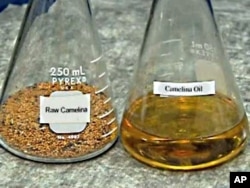The roar of jet engines splits the air over the U.S. Navy's testing grounds in Patuxent River, Maryland, as an F-18 fighter plane takes to the skies. Powering this supersonic jet fighter is a fuel that is 50 percent petroleum-based and 50 percent derived from a seed called camelina.
Amid concerns about climate change, volatile oil prices and, most recently, a massive spill in the Gulf of Mexico, the U.S. Navy and the commercial aviation industry are testing biofuels derived from camelina and other sources as an alternative to crude oil.
Rick Kamin, heads of the Navy's alternative-fuel testing program, has nothing against petroleum.
"Petroleum is great," he says. "We've developed all our systems forever to operate on petroleum. The issue with petroleum is, importing the petroleum, price volatility of petroleum, and shipping a lot of our dollars to buy the petroleum overseas."
Kamin says domestically produced biofuels could help make the Navy's fuel supply more secure -- and less dependent on imported oil -- while helping farmers and workers at home.
Massage oil to jet fuel
Powering supersonic jets is just the latest use for this ancient oilseed.
"If you were a Roman senator, after a hard day at the Forum, you may have walked home and stopped in with your masseuse for a little relaxation and a good massage, and he may have used camelina oil as the lubricant," says
Scott Johnson, president of the biofuel company Sustainable Oils.
Johnson says in the 19th century camelina oil was a popular lamp fuel.
Today, Kamin says, it works just as well as petroleum fuel to power jet airplanes.
"Every test we've put these fuels into our systems, everything has looked no worse than petroleum and sometimes performed even better than our petroleum fuel," he says.
Chemically speaking, it's not surprising, says renewable fuels chief Jim Rekoske at refinery equipment maker Honeywell UOP, because the camelina-based fuel "is not that different from a diesel fuel or a jet fuel."
And fighter plane fuel is not that different from passenger plane fuel. Japan Airlines was one of several that successfully flight-tested biofuels last year.
High cost of petroleum
Recent spikes in oil prices are a big factor driving the interest in biofuels. The airlines still reeling from the 2008 spike in crude oil prices.
"I think with crude oil prices as high as they are, it incentivizes a lot of people to look for the alternative," says John Rau, head of fuels management for American Airlines. "When crude is at 100 dollars a barrel, it changes things pretty dramatically."
But environmental concerns are a factor, too. Burning fuel creates carbon dioxide, a greenhouse gas. Growing plants absorb carbon dioxide as they grow.
Rekoske says the increasing interest in biofuels has created an opportunity to,"number one, extend our business into something that's very important for the environment, and number two, to extend it in an impactful and meaningful way."
In the next decade, Rekoske's goal is for up to one-third of all U.S. transportation fuels to be biofuels, including camelina oil.
Food vs. fuel
But Jim Bartis at the RAND Corporation is not convinced that growing camelina to replace crude oil is such a good idea. According to a study he co-authored at RAND, "Producing just one percent of the oil used in the United States would require 10 percent of all the crop land in the United States," he says. "All crop land. Not just crop land devoted to seed crops. That's a huge amount of displacement."
Displacing all that crop land would affect food production. And if camelina displaces wheat, for example, he says, "That means somewhere else in the world, someone's going to be clearing a forest or grassland so wheat can grow."
Clearing a forest releases large amounts of greenhouse gases that may cancel out the benefits of replacing petroleum.
Right now, the question is moot, because very few farmers grow camelina.
$15 per liter
And, says the Navy's Rick Kamen, "There are no full-scale production plants to make this type of fuel. So there needs to be a commercial investment."
Kamin says commercial investment would bring down the price. The Navy paid about $15 per liter to test camelina fuel, compared to about $1 per liter for petroleum fuel.
Camelina is just one candidate for the biofuel of the future. Others range from animal fats to algae. Honeywell UOP's Jim Rekoske says we'll need them all.
"Those can all provide, by themselves, only a small fraction. But in aggregate, they can now start to make, again, an impactful difference."
A difference that may help change what powers the Navy's fighters, as well as the American economy.













